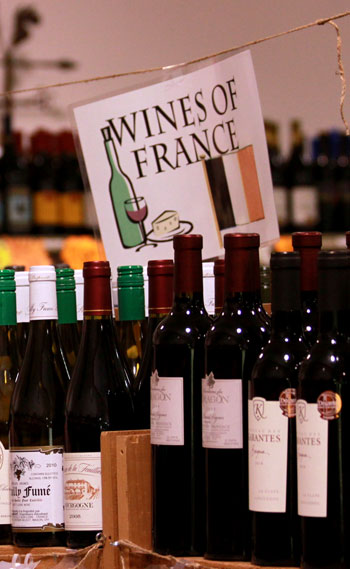A Wine Lover’s New Year’s Resolution: Become a Savvy Buyer
 If you’re browsing E-Romantic’s website, it’s because you’re interested in quality, a bit of mystery mixed in with beauty and originality, and undoubtedly a flair for local flavor.
If you’re browsing E-Romantic’s website, it’s because you’re interested in quality, a bit of mystery mixed in with beauty and originality, and undoubtedly a flair for local flavor.

 That’s why I have a strong inkling that your tastes in wine are similar to mine – at least when it comes to the standards you have for choosing a bottle. Selecting wine can be just as tricky as deciding on a memorable bed and breakfast, so in keeping with the theme of this website, I’d like to offer a few of my latest tips (learned, as you’ll see, from experience) for deciding on quality, beauty, originality, and local flavor in wine.
That’s why I have a strong inkling that your tastes in wine are similar to mine – at least when it comes to the standards you have for choosing a bottle. Selecting wine can be just as tricky as deciding on a memorable bed and breakfast, so in keeping with the theme of this website, I’d like to offer a few of my latest tips (learned, as you’ll see, from experience) for deciding on quality, beauty, originality, and local flavor in wine.
Do your research. On my most recent trip to an unfamiliar wine store, I called ahead to talk to the manager, whom I’ll call David. I gave him an idea of what I was looking for (two whites and two reds for an hors d’oeuvres-only get together) and then listened carefully to his response. Was he enthusiastic? Did he ask me questions to clarify? Did he suggest a number of different choices based on my criteria? The answers to these questions can be very indicative of what kind of wine you will find and what kind of service you can expect at the store. A simple phone call can save you an unnecessary trip or inspire you to go in and learn more about the suggested wines. A natural icebreaker between you and the retailer, calling ahead also means he will be expecting you, and his familiarity with your interests will help him narrow the search.
Once at the store, don’t be shy. If the person assisting you suggests a bottle you haven’t researched, pull out your smartphone and look it up. Retailers are used to people depending more and more on point systems and wine critics’ opinions. While I would highly recommend acknowledging the retailer’s recommendations first, there is nothing wrong with telling him you need a little time with the bottles before making your choice. With that said…
Don’t be fooled by labels or points. On that trip to the new wine store, I chose one wine without David’s help. It was a beautiful bottle of Côtes du Rhone rouge and, written on the bottom of the gold embossed label, a phrase I had come to rely upon attracted my attention: “élevé et mise en bouteille à la propriété.” Today, an increasing volume of juice is farmed out to big-time négociants, where it is produced and bottled under unknown conditions, then sold in mass proportions. A bottle advertising its contents were “raised and bottled on the property” can be a hint to better quality, if the winemaker is honorable. This particular bottle had the added allure of a proper noun, the phrase in question followed by “par Monsieur XYZ.” Finally, a snazzy placard above the wine promoted its 90 point score. While I’m not usually a sucker for points, this time I assumed Monsieur XYZ’s careful growing and bottling must have merited special attention.
I bought several bottles, and (having lost cell reception in the store’s cave) Googled the label once back at my house. Imagine my horror when I found that Monsieur XYZ’s estate produced over 2 million bottles of wine a year, with grapes gathered from – get this – over 45 vineyards! I got back in the car and surprised myself with my own resolve, returning the bottles right away. Careful not to offend my helpful retailer, I admitted to David that I had been tricked by the label.
Ask questions, and ask for a taste. “I didn’t know you were looking for small producers,” said David, taking me back to the French wine selection. He pointed to a Languedoc red I hadn’t considered. “This place is family owned and operated.”
“How many hectares? And do they use traditional production methods?” Obviously, this time I wanted to know more than what was on the label. Eventually, I worked up the courage to ask what he hadn’t offered. “Could I have a taste?”
Many larger wine stores do not budget tastings into their expenses, and thus do not market them as an option for customers. As I found out, however, sometimes all it takes is someone brave enough to ask if it’s possible. David did not hesitate to pop the cork, and even pulled down a second bottle to compare to the one he had suggested. In the back room, amidst boxes of wine and the faint odor of the butcher’s shop next door, we swirled and sniffed and tasted together. It worked out for me, but also for David: I bought a couple bottles each of the wines he opened.
Try different grape varietals and blends. Ever heard of Picpoul de Pinet? I had never tasted this lesser-known varietal, but I didn’t regret trying a bottle. Citrusy, with hints of tropical fruit and peach, it served well as an apéritif. It wasn’t too complex, or oaky, and certainly not buttery, which I learned was an interesting change from California Chardonnay for some of our guests. Arguably the best part about trying different kinds of wine is the affordability: you’re not paying for the name when you buy a Picpoul, and you just might be delighted by the originality of your choice.
There are many schools of thought about how to choose a good bottle of wine. Some people are of the opinion that good wine costs good money, or that all French wine is expensive. But to me, quality doesn’t necessarily have anything to do with price. From what I’ve discovered, a glass of wine that attracts the eye with bright, beautiful color, appeals to the olfactory senses with an interesting bouquet, satisfies the taste buds by complimenting whatever is on the table, and seduces the heart with its authentic, small producer background is a good wine. Here are the four that most recently fit the bill for me and my family at Christmastime:
2010 Sauvion Vouvray. 100% Chenin Blanc from the Loire valley, this is a full-bodied, fruity wine with definite hints of honey. A good choice for those who like their wine just a touch sweet. ($11-$14)
2009 Paul Mas Estate Picpoul de Pinet, from the Languedoc region of southern France. To satisfy guests who prefer a drier wine, the lemony acidity and tropical fruit in this bottle make it a great apéritif. ($11-$15)
2009 Le Pigeoulet en Provence Vin de Pays de Vaucluse. A Grenache blend known for its representation of terroir, this wine is fruity and rich, with hints of licorice and Mediterranean herbs. At our party, it went well with Roquefort – a robust cheese, and it could be easily paired with red meat. ($16-$18)
2009 Château des Karantes Bergerie Rouge, Languedoc. A bit spicier than our other choice of red, this wine’s 40% Syrah component is palatable. A nonetheless easy-to-sip wine that paired well with nearly everything on our hors-d’oeuvres table. ($12-$15)
Like just-picked fruit and hot croissants at a romantic bed and breakfast, the charm of a certain wine often lies in the details. Here’s to finding both a delightful getaway and some superb new bottles in 2012. Santé!
Emily L. Turner is an American writer and budding photographer who divides her time between her old Kentucky home and Burgundy, France. She began her life in France as an exchange student in Dijon, then taught English to primary students for a year in Beaune, and is now pursuing her passion for wine. In addition to freelancing for several print magazines, she writes about her experiences on her blog, EmilyintheGlass and loves to hear from her readers!
by Emily L.Turner
EmilyintheGlass blog: http://emilyintheglass.wordpress.com
Luxury hotels and designer Bed and Breakfasts in Burgundy, Business hotels et Unusual hotels and B&B

